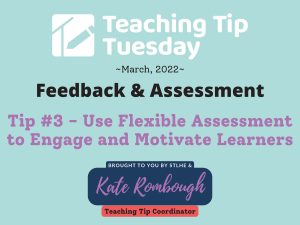
What is Flexible Assessment?
Flexible assessment is competency-based; learners choose their preferred method of assessment to prove how they have met the learning outcomes of the course.
There are multiple ways to be flexible with assessments while challenging students, maintaining rigour, and continuing to provide needed structure (de Bie & Brown, 2017, para. 1). Read about best practices here.
Read through the following resource for an excellent overview of this approach:
- Flexible Learning Resource. (n.d.). Ryerson University. https://www.ryerson.ca/content/dam/mental-health-wellbeing/Documents/Flex-Learning-Res-Full.pdf
Why Should I Use Flexible Assessment?
- Flexibility in assessment can further motivate students and engage them in the learning process by giving them some control over their learning.
- Flexible assessment is inclusive, learning-focused, transparent, and shared.
How Can I Use Flexible Assessment?
Provide learners with the opportunity to personalize their learning experience by allowing them to select the assessment format, the value—within certain limits—that the different assessments will have in determining their final grade, and the deadlines for assignments (read more about flexibility here):
- Use the “bento approach” – offer the same assessments to all learners but a variety of grade weighting schemes, allowing students to change weighting during the term.
- Use the “buffet approach” – offer learners choice of individualized assessments from a menu of possibilities and individualized grade weighting.
- Provide a grace period for assignment deadlines – a flexible late policy still teaches students time management, and other relevant workplace skills, while also respecting their need to balance schoolwork with other responsibilities.
- Another variation is to give two deadlines – for the learners who meet the first deadline, provide a grade and rubric with descriptive feedback; for the learners who submit for the second deadline, provide a grade and rubric only.
Where can I find more about using Flexible Assessment to Engage/Motivate Learners?
- Smith, K. (2019, October 8). Flexible assessment: One instructor’s implementation in a large class. Teaching for Learning @ McGill University. https://teachingblog.mcgill.ca/2019/10/08/flexible-assessment-one-instructors-implementation-in-a-large-class/
- Didicher, N. (2016). Bento and Buffet: Two Approaches to Flexible Summative Assessment. Collected Essays on Learning and Teaching, 9, 167. https://doi.org/10.22329/celt.v9i0.4435
- Success with Assignment Grace Periods. (2022, February 8). Teaching and Learning Innovations at CI. http://tlinnovations.cikeys.com/teaching-learning/success-with-assignment-grace-periods/
…See you next week for a new tip!
References
- de Bie, A. & Brown, K. (2017, May 9). Flexibility in Assessment – Module 6. Pressbooks.com; McMaster University. https://flexforward.pressbooks.com/chapter/flexibility
- Didicher, N. (2016). Bento and Buffet: Two Approaches to Flexible Summative Assessment. Collected Essays on Learning and Teaching, 9, 167. https://doi.org/10.22329/celt.v9i0.4435 CC-BY-3.0
- Elkhoury, E. (2020). A GUIDE TO ALTERNATIVE ASSESSMENTS. https://www.yorku.ca/bold/wp-content/uploads/sites/393/2020/11/Guide_Alternative_Assessments.pdf CC-BY-NC 4.0
Attribution Statement: This resource was adapted from Elkhoury, E. (2020). A GUIDE TO ALTERNATIVE ASSESSMENTS. https://www.yorku.ca/bold/wp-content/uploads/sites/393/2020/11/Guide_Alternative_Assessments.pdf CC-BY-NC-SA 4.0 .
